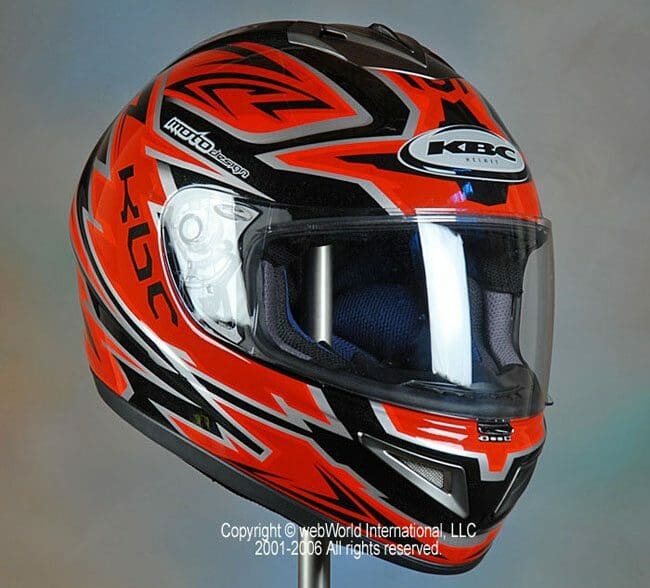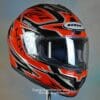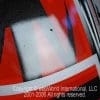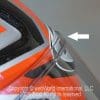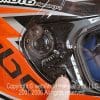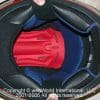It seems like ages ago since we posted a review of the KBC VR-1, the first of KBC’s “VR” series of motorcycle helmets.
The VR-1 put KBC on the map as a motorcycle helmet manufacturer that offered high-end features at rock-bottom prices.
Our conclusion was that the VR-1 offered “excellent value for the money”, it was comfortable and we were pleased with its light weight.
I believe the VR-1 was the lowest priced helmet at that time which not only met DOT safety standards, but also Snell 2000, Euro ECE 22.05 and BS 6658 Type A ACU standards as well.
I remember answering some emails from webBikeWorld visitors who couldn’t believe that an under-two-hundred-dollar helmet could really be Snell approved.
But it was, and it was also surprisingly comfortable and it compared readily with just about anything else for sale at the time, regardless of price.
You’ve been bugging us ever since to review more KBC products, but other than the KBC FF-R flip-up we reviewed after the 2005 Dealer Powersports Expo, we never did get around to any other KBC helmets.
This means we skipped the VR-2 and now the VR-3 has been for sale for some time, so we figured we’d better get to it before the next version (the VR-4?) arrives.
One of the print magazines ran a pictorial recently showing the new KBC factory in China and this also reminded me that it was time to get off my duff and get a VR-3 review posted.
KBC is a Korean-based company and brand, but in an interesting twist on globalization in manufacturing, they apparently decided that the Chinese could make KBC helmets better and cheaper.
However, the KBC VR-3 Stealth shown here was made in Korea, so I’m not sure if the Chinese manufactured helmets are perhaps being distributed in Asia or even if their new Chinese factory is on line yet.
In any case, our general opinion is that the VR-3 still offers that great KBC value for the price, but it definitely is not as revolutionary as the original VR-1, mostly because the competition (read HJC, Bell and others) have gotten so much better.
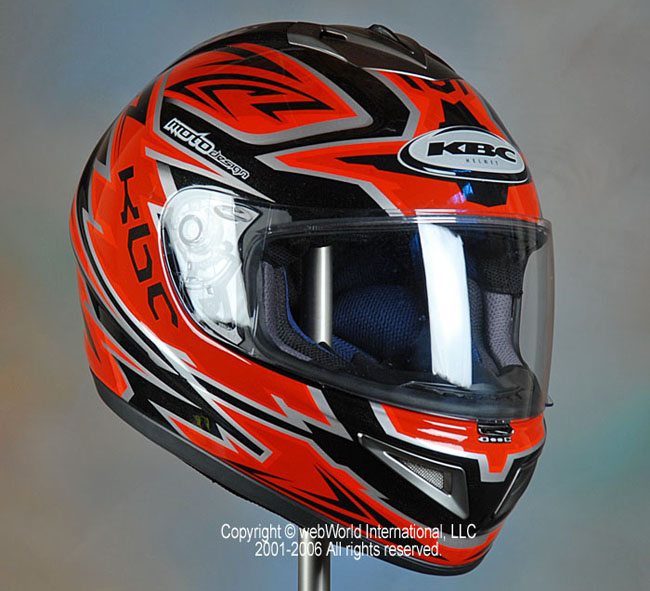
Helmet Weight
Our size XL VR-3 weighs in at 1653 grams (3 lbs., 10-1/4 oz.), which puts it in good company, bracketed with relatively light weight helmets like the Arai Profile (1658g) and the Shoei X-Eleven(1635g).
The VR-3 carries its weight well and doesn’t feel top heavy, nor does it seem to have that “high rotating mass” feeling when the head is moved quickly from side to side for an over-the-shoulder traffic check.
Some of the weight reduction may be due to a shortening of the chin bar and a bare minimum of vents (issues that I’ll get to in a minute), so this is a good news/bad news issue.
We marveled at the lightness of the VR-1, which weighed 1621 grams, but I think that helmet may have been a size large, which could account for the difference. We sold it a long time ago to someone with a motorcycle that was a paint match with the helmet.
The bottom line is that both the internal shape of the VR-3, which fits me perfectly, and the low-ish mass work together to make a comfortable fit. It’s not the lightest helmet in the world, but when a helmet is this well balanced, it doesn’t have to be.
For more information, see the wBW Motorcycle Helmet Weights page for a chart comparing the VR-3 with the other helmets we’ve reviewed.
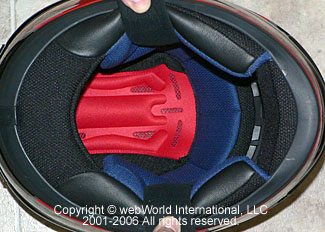
Internal Shape
My feeling is that the VR-3 is a “round head” shape because it fits me perfectly and I seem to be the King of Round Heads. I have a lot of trouble finding helmets that fit me correctly and this one does, which is a real pleasure. I could tell as soon as I slipped it on that it was a match made in heaven.
Our size XL VR-3 seems to be about one-half to one-size smaller than I expected. It fits perfectly, but if it was any smaller it would probably be too tight.
Bill, Burn and I have all noticed that helmet sizes seem to be shrinking recently for some reason. I’m not sure if we’re imagining this, if our heads are swelling or if it’s really happening, but we’re running into the issue too frequently and with too many different brands lately for it to be a coincidence.
This isn’t a problem as long as the helmet fits, but just beware that if you have a head size that is borderline between one size and another, you may want to go for the bigger size. Remember that it’s always helpful to try on the helmet before purchase to see if it fits.
Our Motorcycle Helmet FAQ page has more information on fitting a motorcycle helmet and a discussion on head shapes.
Note that we look at the profile from both a front/back view and down on to the top of the head. The front/back profile is important, because many helmets have one type of fit up top and a different fit down the sides, with various shapes and widths that can affect the helmet fit along the cheekbone (temporomandibular joint), a crucial area for helmet comfort.
Face Shield
I’ve been wearing a pair of eyeglasses with cut-down ear pieces when I ride. This allows the eyeglasses to slip in between the helmet liner and my head, which works great.
I use a pair of clip-on sunglasses because I don’t like to ride with a tinted visor (in the hope that others on the road will see my eyes and realize I’m a fellow human, which will hopefully prevent them from doing something stupid or deliberate).
The problem is that it’s almost impossible to find non-polarized sunglasses any more. The polarization affects vision through a motorcycle helmet visor, causing all sorts of patterns that don’t really affect safety (I think) but make it difficult to evaluate the clarity of a visor.
In any case, the VR-3’s visor seems good enough and it uses a version of the near-standard visor removal system that we’ve (thankfully) encountered on many helmet brands recently.
But this one isn’t quite as easy to use as, for example, the visor removal system on the Bell Apex.
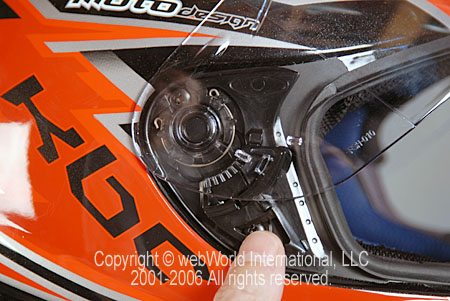
Ours is fussy, because the clamp doesn’t quite open wide enough to release the visor and we have to twist and yank and eventually, maybe, the visor pops off.
Both sides are equally frustrating and although it may loosen up over time and become easier, removing a visor isn’t something we do very often, so I guess this isn’t that big of a problem.
We had another unusual issue with the visor that I think is probably due to a design flaw.
Someone at KBC decided to use a three-dimensional “KBC Helmet” logo in the front of the helmet above the eye port. The logo protrudes out from the surface of the helmet about 2mm.
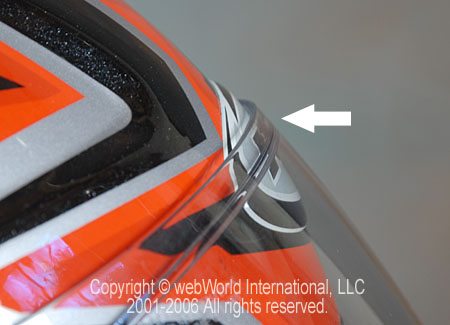
This is compounded by a lip in back of the visor (white arrow, photo above) that seals against a corresponding lip on the eye port gasket.
All of this conspires to cause the visor to snag on the logo when it’s raised or lowered. The interference also prevents the visor from closing that last little bit to seal against the gasket. So every time I lower the visor, I have to push the bottom against the helmet to force it to seal.
Noise Levels
The KBC VR-3 is one of the quieter helmets I’ve worn recently. The unique visor seal seems to prevent any noise from leaking in around the edges.
KBC says that the “visor and its mechanism are designed specifically to interact with the aperture sealing extrusions to provide a perfect seal from wind noise, rain and wind disturbance”, and this seems reasonable.
In the magazine article, KBC mentioned that it is very difficult to maintain a correct radius across the eye port, so perhaps they developed the new, thicker seal to address this problem.
The lip inside the visor that interferes with the 3D logo butts up against a corresponding lip on the top of the eye port gasket, and this also helps to seal out both air leaks and noise.
I noticed some noise around the rear side towards the bottom of the helmet when riding behind a short windscreen that dumps its air on to the lower portion of the helmet. But riding an unfaired bike is a relatively quiet experience with the VR-3, so kudos to KBC for that.
Remember that we always wear correctly fitted, high quality earplugs and an extra helmet liner when riding, and we strongly recommend that you always wear hearing protection also.
See the wBW Earplugs and Hearing Protection page for more information on choosing and wearing earplugs.
Your experience with noise levels may be different, depending upon many factors, including your head shape, motorcycle configuration, prevailing winds and more.
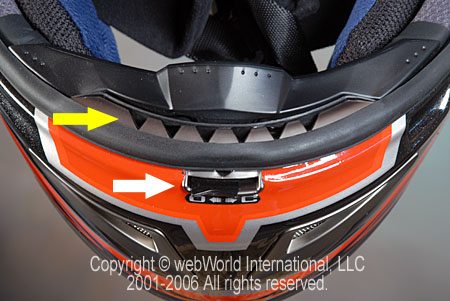
Ventilation and Air Flow
The VR-3 has a basic venting system with a small chin vent and smaller top vent. The dual chin vents direct the air through a screen mesh and up through a saw-tooth opening behind the visor (yellow arrow in the photo above).
This air is directed up in front of the breath guard and up on to the back of the visor.
The problem with this design is that the combined opening volume is very small. I can barely feel any air at all coming through the chin vent.
Unfortunately, there are no air channels cut through the chin bar that could direct the air on to the rider’s face.
The on/of switch (white arrow, photo above) moves the sliding cover under the teeth only about 5mm from left to right to open and close the air flow, which just isn’t enough to make a difference.
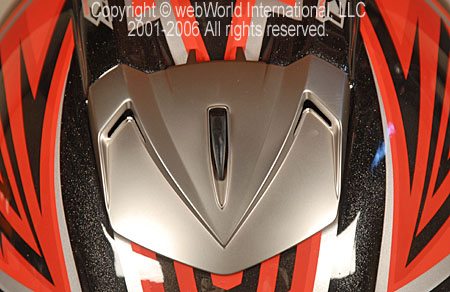
The helmet has a relatively short chin area and the closeness of the chin to the back of the chin bar means that the lack of ventilation is a problem. Besides the paucity of room behind the chin bar, my nose also interferes with the breath guard.
The helmet includes a built-in wind block under the chin, which also prevents any stray air from coming up under the chin and on to the rider’s face.
And although this may serve to lower the noise levels, it closes off the area even more. I find the chin area very stuffy and the lack of decent air flow means that it gets damp and sweaty in there when I ride.
The top vent opens with a sliding switch which can easily be found with gloved hands.
But the vent openings are very small, which means that there isn’t much air that flows through the top of the helmet either.
Although I will say that what little air that does flow through seems to be directed on to the rider’s head through some mesh vents in the top of the liner.

The helmet also has an additional plastic section on the back (photo above), but I can find no air vents in or around the unit, so I’m not sure of its purpose other than perhaps for style.
Overall, I’d rate the top venting as adequate and the chin vent as poor.
Paint, Graphics and Overall Quality
The KBC VR-3 Stealth shown here is supposed to be a 2006 model, but it’s different than the red Stealth design shown on the KBC website. The VR-3 featured on their website looks like an older design to me, but I may be mistaken.
I like the red graphic design on our VR-3 and it’s well done except for several bumps in the paint that I think are the result of poor quality control.
The helmet probably wasn’t adequately cleaned prior to painting, and the dirt shows up under the paint.
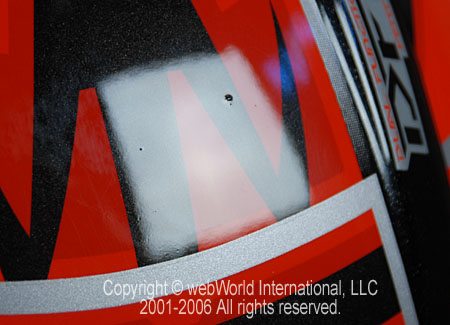
I’ve never seen these on, for example, an HJC helmet, so KBC is going to have to try a little harder with their quality control efforts. It’s a shame that something as simple as this spoils the overall impression of quality, which otherwise is very good.
Miscellaneous
The VR-3 is both DOT and Snell approved in the U.S. KBC claims that the VR-3 “Meets or Exceeds All major worldwide safety standards and tests.
The helmet uses a D-ring attachment system and has a separate button for securing the loose end of the chin strap. The liner is nicely made and it’s comfortable, although not as dramatically different as the liner in the original VR-1.
The Stealth-VR3 shell is made from “specially selected high performance tri-composite Aramid fibers and impact resistant epoxy resins”.
The VR-3 uses the latest bag molded construction which, KBC says, “provides ultra controllable shell integrity and totally consistent shell gauge along with precision accuracy which is essential to allow the correct alignment of such critical mechanisms as visor ratchet action and visor sealing performance”.
Conclusion
The KBC VR-3 is a nice helmet with relatively low noise levels. I find it to be very comfortable and it fits me perfectly. I’m disappointed with the venting and also with the paint issues.
I’ll bet though that if the chin area was slightly roomier and flowed more air that the VR-3 would be one of my favorite helmets. By the way, the price is right — we found this one for $149.95 including shipping and handling!
| wBW Review: KBC VR-3 Helmet | |
|---|---|
| Manufacturer: KBC Helmets (defunct) | List Price (2006): $249.95-$279.95 |
| Colors: Solids and graphics | Made In: Korea |
| Review Date: August 2006 | |
Owner Comments and Feedback
See details on submitting comments.
From “R.”: “I was just reading your review of the KBC VR-3 helmet & I would like to throw in my 2 cents.
First off a little background: I own over 250 various makes and models of helmets, so I can say that I do know something about helmet performance.
Now the VR-3 I’m reviewing is the Strada model which is the same as the one you did, I have also sent my comments to KBC but heard nothing back from them.
First the fit, it is different from the other KBC helmets I own, snug but not uncomfortable. It is tight against the ears but is still a bit noisy and it makes it quite difficult to put on glasses without a little twisting and turning.
I wore this helmet in a 5 hour driving rain and it performed very well with little leakage in the shield area.
My biggest real complaint is the shield mounting system, I have broken off the tab that goes into the ratcheting slot on 4 different shields, I feel this is a very weak area on a critical part of the shield.
The venting is not as you stated a high flow system as it looks and the chin vent is very had to tell if it is open or closed.
Overall I would rate this helmet as a C on a grade scale and I would hope KBC addresses the flaws on the next helmet as I feel this lid is on the right track to become a very good helmet with just a few improvements.”
From “J.B.”: “First and foremost, I would like to say thanks for all the time and effort you guys and/or gals put into each review of a new product.
I’m an avid motorcyclist / racer, and always check your sites for reviews of any products I may be interested in purchasing. Your reviews are honest and no punches are pulled if the product is junk. Thanks.
I recently read your review regarding the KBC VR-3 helmet. I agree regarding the time between your review of the VR-1 and VR-3.
I was very interested in the VR-3 for racing purposes and contacted a KBC rep. I was informed the VR-3 is now classified as a “sport touring helmet” and the VR-2 is their top of the line “racing” helmet. “The VR-2 helmet is a completely different animal” per the rep.
Having been provided this information, I tried on the VR-3 and felt it did not fit me properly nor did it have the snug feel a racing helmet shoulder have. Yes, it was the proper size. It felt, for lack of a proper work, like a cheap helmet.
Now, I directed my attention to the “New for 2006″ VR-2 Daytona.
WOW! What a difference. It was comfortable, well made and felt like a top of the line helmet. If I may make a suggestion, I think webBikeWorld should review the new VR-2 and make a comparison. I think you will be pleasantly surprised. Just a suggestion.
Thanks again for helping out the motorcycling community.”
Editor’s Note: Thanks for the tip, I’ll see what we can do.


